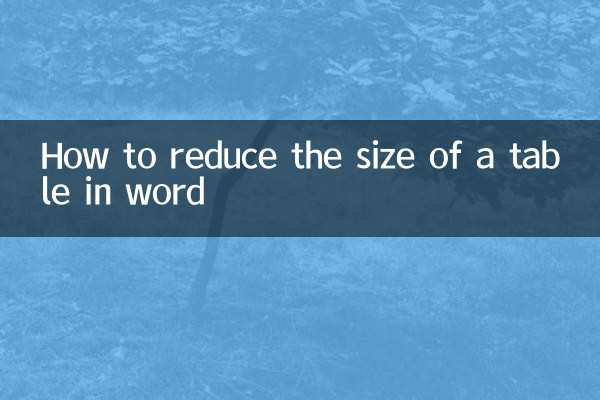How to reduce the size of a table in Word
In daily office or study, we often need to insert tables into Word documents to organize data. But sometimes the table is too large, which affects the overall layout of the document. This article will introduce in detail how to reduce the size of tables in Word and provide structured data to help you quickly master the operation skills.
1. Basic methods to reduce the size of Word tables

Here are a few common ways to shrink a Word table:
| method | Operation steps | Applicable scenarios |
|---|---|---|
| Drag to adjust | Select the table and drag the zoom handle in the lower right corner of the table | Fast overall scaling |
| Column width adjustment | Place the cursor on the column separator line and drag to adjust | Fine-tune specific columns |
| row height adjustment | Place the cursor on the line separator and drag to adjust | Fine-tune specific rows |
| table properties | Right-click the table→Table Properties→Specify Size | Precisely control table size |
2. Advanced techniques for reducing Word tables
In addition to the basic methods, there are some advanced techniques that can help you resize tables more efficiently:
| Skill | Detailed description | Effect |
|---|---|---|
| automatic adjustment | Right-click the table → Automatically adjust → Adjust according to content/window | Intelligent adaptation |
| font size reduced | Select all table contents and reduce font size | indirect table reduction |
| Merge cells | Select adjacent cells → Merge cells | Reduce table space |
| Table to text | Table Tools → Convert to Text | Completely remove table formatting |
3. Frequently Asked Questions about Word Table Reduction
The following are the problems and solutions that users often encounter when shrinking Word tables:
| question | reason | Solution |
|---|---|---|
| Table cannot be reduced | Fixed row height/column width set | Cancel fixed values in table properties |
| Incomplete content is displayed | Zoom out too much | Adjust row height/column width or reduce font size |
| Table deformation | Improper drag ratio | Hold down the Shift key to maintain proportional dragging |
| Confusing format | Cell margin issue | Adjust cell margins in table properties |
4. Hot topics and content on the entire network (last 10 days)
In order to enrich the content of this article, we have compiled recent hot topics across the Internet. These data may inspire your work and life:
| Ranking | hot topics | heat index | Main platform |
|---|---|---|---|
| 1 | New breakthroughs in AI technology | 9.8 | Weibo, Zhihu |
| 2 | healthy eating in summer | 9.5 | Douyin, Xiaohongshu |
| 3 | Summer travel guide | 9.2 | Mafengwo, Ctrip |
| 4 | Office software skills | 8.9 | Station B, public account |
| 5 | New energy vehicle trends | 8.7 | Autohome, understand car emperor |
5. Summary
Through the introduction of this article, I believe you have mastered various methods of reducing tables in Word. Whether it's a simple drag adjustment or precise control through table properties, it can help you better layout your document. At the same time, understanding recent hot topics will also help you grasp the pulse of the times and obtain more useful information.
In actual operation, it is recommended to choose the appropriate method according to specific needs. If you only need temporary adjustments, dragging and zooming is the fastest way; if you need precise control, you should use table property settings. Remember, good document formatting not only enhances the reading experience, but also demonstrates your professionalism.

check the details

check the details